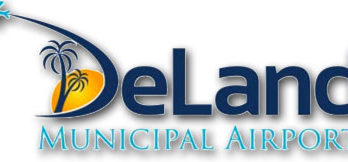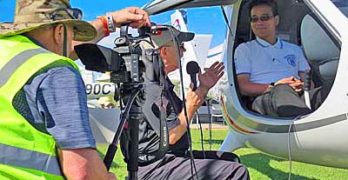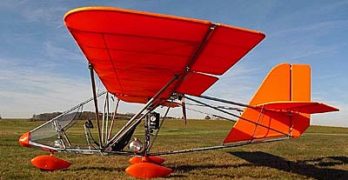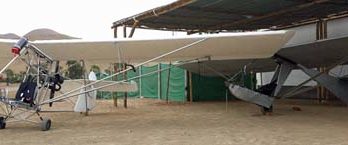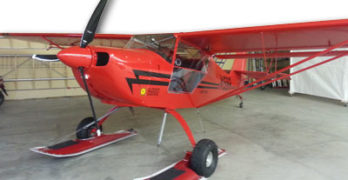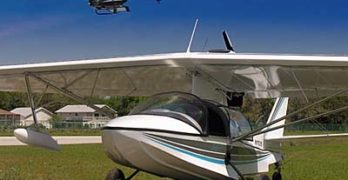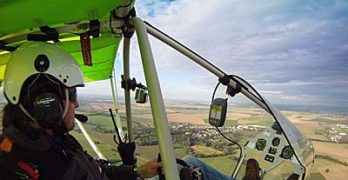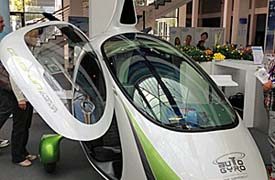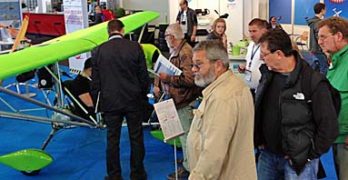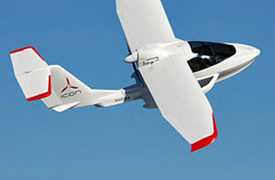What’s in a name for an airshow? Quick, what’s the official name of the big July show north of Chicago? “Oshkosh?” Yes, to most, but the association prefers EAA AirVenture Oshkosh. How about the one in Lakeland, Florida? “Oh, you mean Sun ‘n Fun.” The full name is Sun ‘n Fun International Fly-In and Expo. Have you ever heard anyone say the whole thing? Another mouthful is Sebring U.S. Sport Aviation Expo, but it gets shortened various ways.
At Sun ‘n Fun 2016 DeLand airport Manager John Eiff and recently hired Sport Aviation Administrator Jana Filip held a name-that-show contest. More than 30 entries were received. “Some were very clever and witty like DeLand, DePlanes, DeShow,” said Jana. In the end, the winning word was “Showcase,” offered by veteran Paradise City Commentator, Michael McClellan.
Why Showcase? “Because that’s what the event will be — a showcase for airplanes and aviation stuff,” McClellan said.
Search Results for : Aerolite 103
Not finding exactly what you expected? Try our advanced search option.
Select a manufacturer to go straight to all our content about that manufacturer.
Select an aircraft model to go straight to all our content about that model.
Sun ‘n Fun 2016 Debrief & Summary
The super-short summary of Sun ‘n Fun 2016: weather was beautiful; even the one night of rain gave way to a sunny day and all other days were as good as it gets. No accidents occurred to my awareness. Crowds were good if not record-setting. Airplanes were sold; I conservatively estimate about 30 sales of light aircraft, based on my inquiries. What’s not to love?
As with any such attempt to cover an event the size and breadth of Sun’n Fun, this article cannot include all deserving aircraft, with regrets to any not mentioned below. We also shot lots video that will follow as the editing can be done (photo).
This article is longer than I prefer but I have plenty to tell you and I was simply too engaged during the event to keep posting. So… let’s get going!
AIRPLANES (three-axis control) — Sun ‘n Fun drew all the wonderful light airplanes we love but a few were touting fresh news not previously reported.
Sun ‘n Fun Preview … 17 Aircraft to Check
Every year before the big shows, I often hear from journalist friends working for other publications. This year as other years, they need advance knowledge to get things started for print publications working on longer deadlines than those of us in the online publishing game. To help my fellow writers, I’ve been keeping a tally of what I expect at Sun ‘n Fun 2016. Here we go…! By the way, these are not order of importance or impact. Please don’t assume.
U-Fly-It, producer of the popular and agreeably-priced Aerolite 103 (ready-to-fly for well under $20,000) is well along in planning for a kit version. While running their facility at or near capacity, this move may help get airplanes to people faster plus allowing those who want features that will not qualify as a Part 103 ultralight to go Experimental Amateur Built.
Thinking of modestly priced aircraft, Quicksilver will be represented at Sun ‘n Fun at the Air-Tech space.
What Will 15 Days and $15,000 Get You?
This website focuses on the affordable end of aviation. However, “affordable” is a relative term. I’ve written about Icon’s A5, which may set the bar highest among Light-Sport Aircraft at around $247,000 for a well-equipped LSA seaplane. (See our Video Pilot Report.) If you had the money would you buy an A5 or a Cessna 172 Skyhawk for around $400,000. You probably have a response but then, the question is rhetorical because most readers likely don’t have a quarter-million to do drop on a LSA, no matter how magnificent it may be.
I’ve also written about the $16,000 (or so) fully-built Aerolite 103. Some think that’s a wonderful deal on a very nice single seat airplane. Yet at least one person wrote on my Dan Johnson Media / Affordable Aviation Facebook page that even Aerolite is too expensive. Fair enough. We all have different budgets.
7 Aircraft to Look for at Sebring 2015
We’re off to the races … OK, the race track … OK, we’re off to Sebring, which happens to be alongside the Sebring International Raceway. Yep. It’s January so it’s again time for the Sebring Expo, this time number 11, the 2015 edition of the popular Florida show. I’ll be onsite for the four days, which this year is one day sooner, running Wednesday through Saturday. The plan makes it easier for vendors to stay to the end on Saturday and still have time to get home on Sunday so they can be back in their businesses on Monday.
Every time I head to a show people contact me, including journalists from publications that don’t follow Light-Sport, light kits, ultralights, or light GA as closely as we do). The question is always the same. What new aircraft or products will we see at the show? …Uh, let me think.
Fresh American LSA & Ultralight Exports
Wait! “…Exports?” I realize that might look like a typo. Did I intend to write LSA imports? Nope, exports is the correct word. Back in the early days of Light-Sport Aircraft, circa 2005-6-7, the source countries manufacturing the LSA people were buying were of a high percentage European with the Czech Republic leading the charge. Their penetration of the market was approximately two-thirds of all LSA. Then came the global economic recession, which happened as the industry began to mature. All were affected: domestic and international companies and pilot consumers. Some handsome imported aircraft never found a market.
In any downturn, some managers adapt quicker to the changing economy. They find a way to offer new aircraft to keep the momentum. Neither were American companies sitting on their thumbs. European builders had a head start because the European-style ultralights they had been manufacturing were close to what FAA allowed as LSA, so many models could be rapidly adapted to meet the Yankee marketplace.
Light Is Right In the Eyes of FAA and World CAAs
Evidently, a magic number exists to authorities in various civil aviation agencies around the developed world. That magic number — more correctly a range — is 115 to 120 kilograms, or 253 to 264 pounds. FAA led this charge way back in 1982 with the introduction of FAR Part 103 codifying that an airplane, ‘er … “ultralight vehicle” with an empty weight of 254 pounds — subject to certain exceptions for emergency airframe parachutes or float equipment — could be flown without three requirements common to all other aircraft. Part 103 vehicles• do not require registration (N-numbers); the pilots of these ultralights need no pilot certificate of any kind; nor do they need a medical. Such aircraft can be sold fully built, ready to fly. The entire regulation governing their use can be printed on the front and back of a single page of paper. This simply must be one of the most remarkable deregulatory efforts in all of aviation.
Aero 2014 Review … Starting to Think AirVenture
Life has settled down a little after the rush that began at the end of March. Five weeks back, Sun ‘n Fun was approaching to kick off the season of recreational flying.
Aero in Germany followed with only a one day break before boarding the airliner to Europe followed by plenty of follow-up and contemplating the hot and fast action. With a couple weeks of perspective and to answer a common question — How does the industry look in Europe? — I have some final observations.
I found five areas to consider and list them below. Among all the many wonderful aircraft I saw, two particular subgroups stood out for me personally, one for its sheer success and the other for its subtle return to a higher interest plateau.
I refer first to gyroplanes and secondly to, well … what to call them? How about simply “ultralights?” Even that word isn’t right because Ultralight in Europe means something quite different from ultralight (vehicle) in the USA.
Surprise Star of the Show at Aero?
It depended on whom you asked. As in the United States some were skeptical at Aero. “Oh, this will go nowhere.” “No one is interested” “We tried this and it didn’t work.” Maybe these naysayers are right, but the activity at one booth (or “stand” as they prefer in Europe) seemed to powerfully counteract that doubt. The stand was the Hirth exhibit which featured a variety of aircraft using the German powerplant. The one and only American aircraft example in the Hirth exhibit — indeed, perhaps the only light aircraft at Aero that was Made in the USA — was the Aerolite 103, or as it has been renamed here, Aerolite 120. Why the different name and why the strong interest? To clarify, by strong I mean an airplane sometimes so surrounded by attendees that you could not even get close. As further proof, Aerolite 120 was written up by several publications during the four days of Aero and also garnered television coverage.
Light Aircraft Weight … More or Less?
Several aviation sources recently carried news about Icon Aircraft and their A5 LSA seaplane development. Icon Aircraft has been waiting — surely with increasing impatience — for FAA to answer their formal request for exemption to the Light-Sport Aircraft gross weight parameter. FAA normally replies in 120 days, however, more than a year passed and all that arrived was a request for more detail. One can imagine the cries of angst at Icon. Many have wondered when (or if) this handsome aircraft will go to market but if you were part of their leadership, what would you go into production with … a 1,430-pound seaplane or one at the new requested weight of 1,680 pounds? Either way, what if FAA later changed their mind about an exemption they might grant. Recent news about the IRS makes us all aware government agencies don’t always operate as we expect. What a vexing situation for Team Icon.
- « Previous Page
- 1
- …
- 3
- 4
- 5
- 6
- 7
- Next Page »


